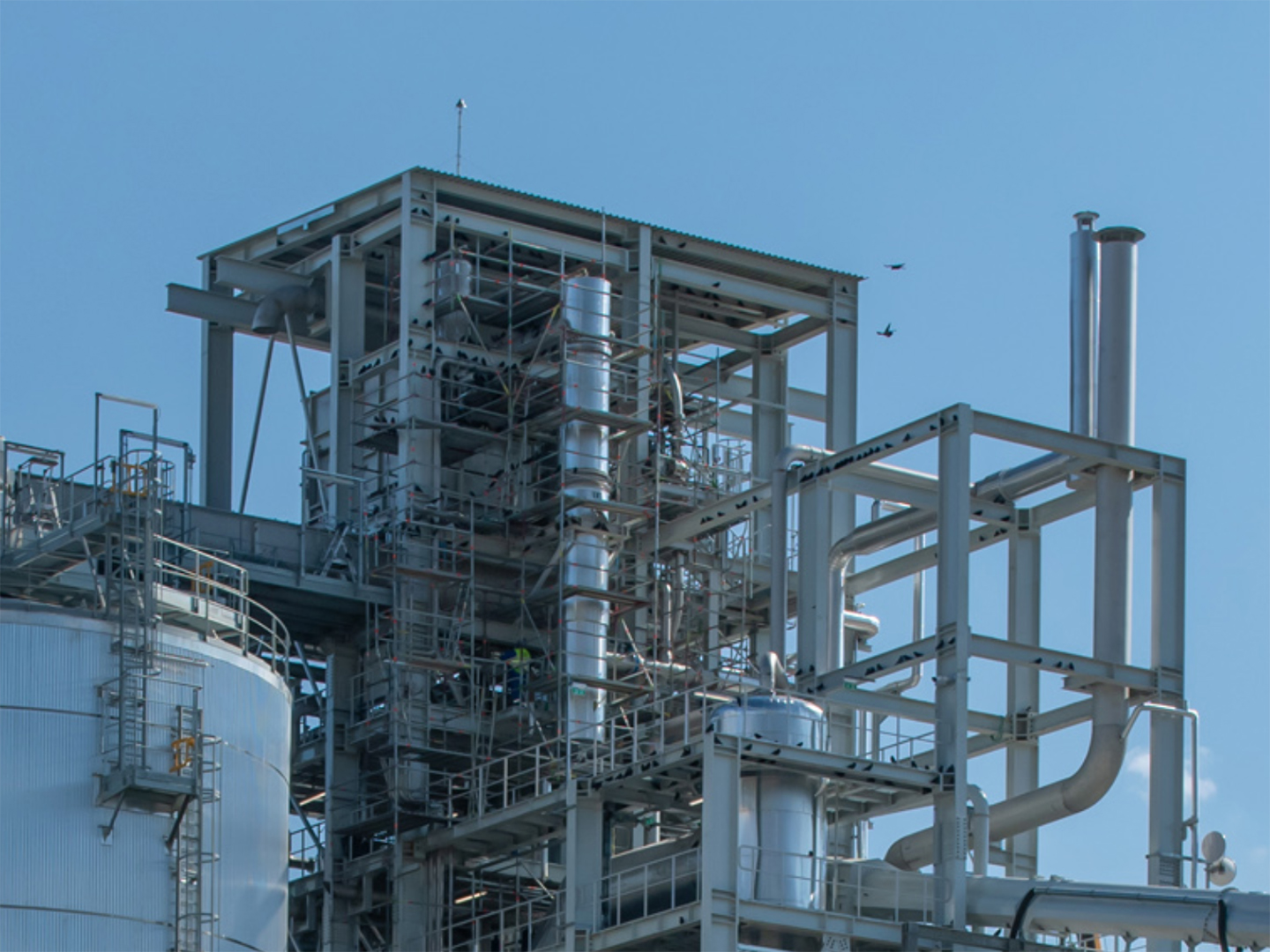Catalysis
General information
The Business AreaBusiness AreaFor the financial reporting, Clariant grouped its businesses in three core Business Areas: Care Chemicals, Catalysis, and Natural Resources. Catalysis comprises the Business Unit Catalysts and the Business Line Biofuels & Derivatives. It develops, manufactures, and sells a wide range of catalyst products and technologies for the chemical and fuel industries, for emission control, as well as for the biofuel business. Its products contribute significantly to value creation in its customers’ operations, making use of finite raw materials and energy efficiently and effectively, ensuring quality and yield of processes.
The business area profits from several business drivers:
- the need to increase energy efficiency and sustainability in chemical production;
- the desire to decarbonize the transport sector;
- the search for sustainable, emission-free mobility solutions;
- growing interest in circular economy solutions through the extensive use of renewable resources;
- increasing legal requirements for renewable energy sources.
The Business AreaBusiness AreaFor the financial reporting, Clariant grouped its businesses in three core Business Areas: Care Chemicals, Catalysis, and Natural Resources. Catalysis has 17 production sites (including joint ventures), 21 sales offices, and 11 Research & Development and Technical Centers around the world. It serves customers globally, with a special focus on Europe, China, North America, and the Middle East.
CATALYSIS
OVERVIEW
Business AreaBusiness AreaFor the financial reporting, Clariant grouped its businesses in three core Business Areas: Care Chemicals, Catalysis, and Natural Resources. Catalysis compromises Business Unit Catalysts and Business Line Biofuels & Derivatives. Products of Business Unit Catalysts are used for chemical production, fuel processing, and emission control. Its »custom catalysts« business helps customers to scale up and commercialize their new catalyst recipes. Business Line Biofuels & Derivatives complements the offering with sunliquid®, a groundbreaking technology to produce biofuels and biochemical intermediates from agricultural residues.
APPLICATIONS
Business Unit Catalysts
- Ammonia
- Custom catalysts
- Ethylene & derivatives
- Fischer-Tropsch
- Fuel cell
- Fuel upgrading
- Gas processing
- Hydrogen
- Hydrogenation
- Methanol
- Methanol-to-propylene (MTP)
- Off-gas treatment for chemical plants and stationary engines
- Olefins purification
- On-purpose propylene
- Oxidation
- Polypropylene
- Refinery stream purification
- Styrene
- Zeolite powders
Business Line Biofuels & Derivatives
- Biocatalysis
- Cellulosic ethanol
- Cellulosic sugars
- Low-carbon advanced biofuels
- Residue-derived biochemical intermediates
PRIORITY SDGs
- SDG 7 Affordable and Clean Energy
- SDG 9 Industry, Innovation, and Infrastructure
- SDG 12 Responsible Consumption and Production
- SDG 13 Climate Action
Business Unit Catalysts
There are several hundred products offered in the Business Unit Catalysts portfolio. With these products, customers save energy and reduce emissions. Based on decades of experience in the development and production of custom catalysts, Clariant also helps customers to scale up and commercialize new catalysts.
For example, the emission-control catalyst line EnviCat® removes harmful chemical compounds with an excellent conversion efficiency. Used all over the world, EnviCat® catalysts also help customers meet China’s strict new regulations concerning the improvement of air quality.
Another flagship product is MegaMax® 800, a state-of-the-art methanol synthesis catalyst that offers much higher activity than previous solutions – even at very low reactor temperatures and pressures. Capturing and converting CO2 emissions is a cornerstone of the technology road map for addressing climate change. Synthesizing methanol from CO2 is a particularly valuable approach because methanol is a building block for many chemical products such as plastics, paints, cosmetics, and fuels. MegaMax® 800 significantly improves efficiency and increases lifetime productivity in comparison to standard methanol synthesis catalysts.
Business Line Biofuels & Derivatives
Biotechnology provides unique opportunities for Clariant to meet its customers’ demand for more sustainable production chains and for energy supply on a renewable basis. In 2021, the Business Line Biofuels & Derivatives therefore developed additional products and technologies that provide a measurable advantage for our customers to reduce greenhouse gas emissions. The business line’s flagship product is the sunliquid® technology, which converts agricultural residues into cellulosic ethanol. The bioethanol produced by the sunliquid® process significantly reduces CO2 emissions, thereby helping decarbonize the transport sector. The cellulosic ethanol produced by our sunliquid® technology can reduce up to 95 % of CO2 emissions compared to fossil fuel and as much as 120 % when carbon sequestration is considered and used as part of the production process.
Market dynamics in 2021
In 2021, customers had to face increasing costs in many areas: Natural gas prices in Europe were particularly high, as were coal prices in China and metal prices globally. Rising freight costs also had a negative impact on most businesses. At the same time, supply chains continued to prove unstable in the second year of the COVID-19 pandemic. Furthermore, customers felt rising social and legislative pressure to reduce their CO2 footprints, which in turn increased their demand for more sustainable solutions. Against this background, the demand for Clariant’s syngas and emission-control catalysts recovered in 2021, and even accelerated throughout the year.
Rising oil prices led to a rapid increase in the demand for and production of bioethanol, which can be used as an inexpensive biofuel to reduce transportation costs. In addition, bioethanol helps to comply with political regulations concerning the use of sustainable fuels. Some governments even grant funding for the use of bioethanol in order to support sustainable transportation.
How the Business Area Catalysis created value in 2021
In the full year 2021, sales in the Business AreaBusiness AreaFor the financial reporting, Clariant grouped its businesses in three core Business Areas: Care Chemicals, Catalysis, and Natural Resources. Catalysis increased by 5 % in local currency and by 3 % in Swiss francs. Sales rose in Syngas, Specialty Catalysts, and the emission-control catalyst businesses, which more than offset the slightly weaker development in Petrochemicals, though demand for CATOFIN® catalysts was strong.
In the full year 2021, the EBITDAEBITDAEarnings before interest, taxes, depreciation, and amortization. margin fell to 16.8 % from 19.2 % in the previous year as a result of the less favorable product mix with a higher contribution from the lower-margin emission-control businesses, logistics constraints, as well as project effects related to the sunliquid® production plant in Romania and the new CATOFIN® production site in China.
Though margins can fluctuate significantly over the quarters of a calendar year, the fundamentals for Catalysis remain positive based on the present demand pattern, the order backlog, portfolio strength, and proven innovation capability.
New products
In 2021, Clariant developed MegaMax® 800 DCARB, a new catalyst that enables CO2-based methanol synthesis to produce »green« methanol. The catalyst outperforms previous generations and benchmarks in carbon efficiency, mechanical stability, and product life span.
In July 2021, Clariant’s new AmoMax® 10 Plus ammonia synthesis catalyst started up at the BASF plant in Antwerp, Belgium. This catalyst has higher activity, enabling increased ammonia yield or lower energy costs and CO2 footprint. BASF selected AmoMax® 10 Plus after good experience with the previous product generation at Freeport, Texas. Compared to standard ammonia synthesis catalysts, AmoMax 10 Plus allows significant energy savings with an expected CO2 reduction of up to 125 000 tons of CO2 emissions for a 2 000-mtpd ammonia plant over the course of the typical catalyst lifetime of 15 years.
Clariant also made great progress in the reporting year with respect to sunliquid®, its groundbreaking technology to produce biofuels and biochemical intermediates using microorganisms and enzymes. sunliquid® cellulosic ethanol is ready to use in the framework of the existing transportation infrastructure. Agricultural residues like wheat straw and corn stover from local farmers serve as feedstock. At Hannover Messe 2021, Clariant presented a feasibility study together with Indonesia’s state-owned oil and gas company Pertamina. Based on this study, it broadened the feedstock portfolio to fruit and palm biomasses. The sunliquid® process shows a flexibility on a broad range of feedstock. Process conditions & biocatalysts were developed and performance runs executed in Clariant’s precommercial plant in Straubing, Germany, for a wide range of lignocellulosic biomass.
Through the sunliquid® licensing strategy, Clariant enables its customers to build their own bioethanol plants. The offering covers all parts of the ethanol production chain. Until 2021, Clariant licensed the technology to five large industry players in Slovakia, Poland, China, and Bulgaria.
New initiatives
In 2021, Clariant teamed up with Linde Engineering to develop new catalysts for the oxidative dehydrogenation of ethane. This is an innovative, low-emission catalytic technology for the production of ethylene. Clariant’s novel catalysts make this technology commercially feasible, reducing CO2 emissions by up to 100 % compared to conventional technologies.
In collaboration with Technip Energies, Clariant launched EARTH, a pioneering technology for steam methane reforming and syngas production that reduces the CO2 footprint of the process by up to 20 %. EARTH technology demonstrated excellent performance in its first commercial application. In 2021, two major contracts for EARTH were concluded.
In November 2021, Clariant also launched a major climate campaign to reduce the climate change impact of emissions caused by nitric acid production. N2O is around 300 times more harmful to climate than CO2. Clariant’s EnviCat® N2O-S catalyst can effectively remove up to 95 % of this by-product of nitric acid production. In the context of this campaign, the company offers a free first fill of the catalyst to ten nitric acid producers worldwide who do not have N2O off-gas treatment in place. With this campaign, Clariant intends to help avoid greenhouse gas emissions equivalent to several million tons of CO2 every year.
New locations
Increasing awareness of sustainability fuels global demand for technologies that increase energy efficiency in industrial processes. That is why Clariant extended its production capacities for catalysts in 2021. For example, it commenced operations for its emission-control catalysts EnviCat® at an additional, upgraded production facility in Heufeld, Germany. It features state-of-the-art production equipment exclusively dedicated to emission-control catalysts.
In October 2021, Clariant completed the construction of its first commercial-scale sunliquid® cellulosic ethanol production plant in Podari, Romania. This innovative flagship plant serves as a proof point for the company’s ambitious growth strategy. It will process approximately 250 000 tons of straw – provided by more than 300 local farmers – and produce approximately 50 000 tons of cellulosic ethanol annually. This second-generation biofuel will be almost carbon neutral, as coproducts produced by the process will be used for the generation of renewable energy, making the plant almost independent of fossil energy sources. While the cellulosic ethanol can be used as a drop-in solution for fuel blending, it also offers further downstream application opportunities into bio-based chemicals and for sustainable aviation fuel.
In collaboration with Air Liquide, Clariant made another major breakthrough in methanol synthesis performance. It equipped two world-scale methanol plants in Asia with its new MegaZonE™ technology, a novel catalyst layering system, which elongates catalyst lifetime by up to two years and increases methanol production by up to 15 %. MegaZonE™ offers significant monetary benefits for customers and has the potential to reduce their CO2 footprint substantially.
Innovative products such as these are often the result of close cooperation with customers. In order to intensify these efforts, Clariant opened a catalyst contract R&D center in Shanghai, China, in March 2021. It is located at the new »One Clariant Campus,« which is part of Clariant’s commitment to local innovation and growth in the dynamic Chinese market. The state-of-the-art catalyst contract R&D center will focus on four fields addressing China’s megatrend to drive sustainability and efficiency: more sustainable solutions for the coal value chain, hydrogenation for high-value-adding chemicals, environmental protection, and custom catalysis. To date, only few international companies have built such a comprehensive catalyst research unit in China.
Certifications and awards
Clariant works toward solutions to further reduce the CO2 footprint of ammonia synthesis with its AmoMax® line. One example of this is AmoMax®-Casale, jointly developed with Casale. The new catalyst is tailor-made for Casale ammonia synthesis converters and offers a larger active surface area, which allows operation of the ammonia synthesis loop with considerably less pressure. This results in an efficiency factor that is up to 30 % higher. Thus, the plant consumes less energy to produce ammonia, and, hence, generates fewer CO2 emissions.
Clariant and Casale won two awards for AmoMax®-Casale: the Swiss Chemical Society’s Sandmeyer Award in 2021, and the prestigious Independent Commodity Intelligence Services (ICIS) Innovation Award for »Process with Best Benefit to the Environment and Sustainability« in 2020.
Ongoing developments
In 2021, the Business AreaBusiness AreaFor the financial reporting, Clariant grouped its businesses in three core Business Areas: Care Chemicals, Catalysis, and Natural Resources. Catalysis ran a number of notable innovation activities that we will be continued in 2022:
Commissioning for Clariant’s sunliquid® plant in Podari, Romania, is ongoing. The company has already contracted the entire annual production output to a major global oil and gas corporation under a multiyear agreement. Production is expected to start in H1 2022.
In 2020, Clariant broke ground on a new high-tech production site for CATOFIN® catalysts in Jiaxing, Zhejiang Province, China. Construction of the plant was concluded at the end of 2021 in only 16 months, and the ramp-up is expected to take place in the first half of 2022. Although the first phase will focus on the CATOFIN® propane dehydrogenation catalyst, this facility was constructed with the potential to expand to the production of more catalysts in the future and also includes a research and pilot plant. It will be Clariant’s third catalyst production site in China and is an ideal example of how the company continues to support China’s petrochemical industry growth as Clariant expands its presence in the region.
Business Area Catalysis
6.0 %
R&D spend of sales
> 90
Active innovation projects
1 061
Number of raw materials procured
290.8
Raw materials procured in CHF m
17
Production sites
534
Raw material suppliers
34 641
Training hours
607.5
Energy consumption in m kWh
907
Sales in CHF m
16.8 %
EBITDAEBITDAEarnings before interest, taxes, depreciation, and amortization. margin
0.06
Production volume in m t
5 %
Growth in local currencies
2 174
Staff in FTEs at year-end
31.0
Waste in thousand t


